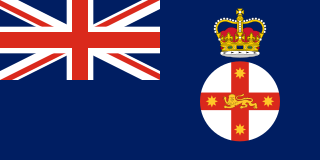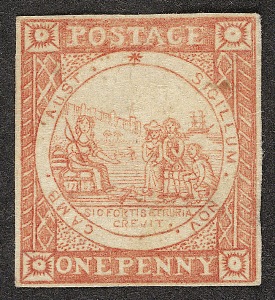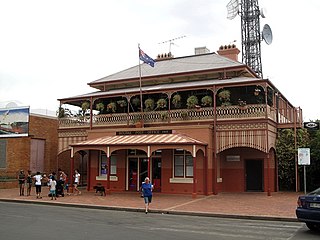
The Governor of New South Wales is the viceregal representative of the Australian monarch, Queen Elizabeth II, in the state of New South Wales. In an analogous way to the Governor-General of Australia at the national level, the Governors of the Australian states perform constitutional and ceremonial functions at the state level. The governor is appointed by the queen on the advice of the premier of New South Wales, for an unfixed period of time—known as serving At Her Majesty's pleasure—though five years is the norm. The current governor is retired judge Margaret Beazley, who succeeded David Hurley on 2 May 2019.

New South Wales is a state on the east coast of Australia. It borders Queensland to the north, Victoria to the south, and South Australia to the west. Its coast borders the Coral and Tasman Seas to the east. The Australian Capital Territory is an enclave within the state. New South Wales' state capital is Sydney, which is also Australia's most populous city. In March 2019, the population of New South Wales was over 8 million, making it Australia's most populous state. Just under two-thirds of the state's population, 5.1 million, live in the Greater Sydney area. Inhabitants of New South Wales are referred to as New South Welshmen.

The Australia Act 1986 is the short title of each of a pair of separate but related pieces of legislation: one an Act of the Commonwealth Parliament of Australia, the other an Act of the Parliament of the United Kingdom. In Australia they are referred to, respectively, as the Australia Act 1986 (Cth) and the Australia Act 1986 (UK). These nearly identical Acts were passed by the two parliaments, because of uncertainty as to whether the Commonwealth Parliament alone had the ultimate authority to do so. They were enacted using legislative powers conferred by enabling Acts passed by the Parliaments of every Australian state. The Acts came into effect simultaneously.

This is an overview of the postage stamps and postal history of Australia.

This is a survey of the postage stamps and postal history of New South Wales, a former British colony now part of Australia.

Australian constitutional law is the area of the law of Australia relating to the interpretation and application of the Constitution of Australia. Several major doctrines of Australian constitutional law have developed.

The Government of New South Wales, also referred to as the New South Wales Government or NSW Government, is the Australian state democratic administrative authority of New South Wales. It is currently held by a coalition of the Liberal Party and the National Party. The Government of New South Wales, a parliamentary constitutional monarchy, was formed in 1856 as prescribed in its Constitution, as amended from time to time. Since the Federation of Australia in 1901, New South Wales has been a state of the Commonwealth of Australia, and the Constitution of Australia regulates its relationship with the Commonwealth. Under the Australian Constitution, New South Wales ceded legislative and judicial supremacy to the Commonwealth, but retained powers in all matters not in conflict with the Commonwealth.

The Colony of New South Wales was a colony of the British Empire from 1788 to 1900, when it became a State of the Commonwealth of Australia. At its greatest extent, the colony of New South Wales included the present-day Australian states of New South Wales, Queensland, Victoria, Tasmania, and South Australia, the Northern Territory as well as New Zealand. The first "responsible" self-government of New South Wales was formed on 6 June 1856 with Sir Stuart Alexander Donaldson appointed by Governor Sir William Denison as its first Colonial Secretary.

Kable v Director of Public Prosecutions for NSW, was a significant case decided in the High Court of Australia regarding the independence of the judiciary under the Constitution of Australia.
The doctrine of the separation of powers in Australia divides the institutions of government into three branches: legislative, executive and judicial. The legislature makes the laws; the executive put the laws into operation; and the judiciary interprets the laws. The doctrine of the separation of powers is often assumed to be one of the cornerstones of fair government. A strict separation of powers is not always evident in Australia; instead the Australian version of separation of powers combines the basic democratic concepts embedded in the Westminster system, the doctrine of "responsible government" and the United States version of the separation of powers. The issue of separation of powers in Australia has been a contentious one and continues to raise questions about where power lies in the Australian political system.
The reserved powers doctrine was a principle used by the inaugural High Court of Australia in the interpretation of the Constitution of Australia, that emphasised the context of the Constitution, drawing on principles of federalism, what the Court saw as the compact between the newly formed Commonwealth and the former colonies, particularly the compromises that informed the text of the constitution. The doctrine involved a restrictive approach to the interpretation of the specific powers of the Federal Parliament to preserve the powers that were intended to be left to the States. The doctrine was challenged by the new appointments to the Court in 1906 and was ultimately abandoned by the High Court in 1920 in the Engineers' Case, replaced by an approach to interpretation that emphasised the text rather than the context of the Constitution.
Section 51(v) of the Constitution of Australia is a subsection of Section 51 of the Constitution of Australia that gives the Australian Parliament power to legislate on "postal, telegraphic, telephonic, and other like services".
In Australian constitutional law, Chapter III Courts are courts of law which are a part of the Australian federal judiciary and thus are able to discharge Commonwealth judicial power. They are so named because the prescribed features of these courts are contained in Chapter III of the Australian Constitution.

The Constitution of Australia, or Australian Constitution, is the supreme law under which the government of the Commonwealth of Australia operates, including its relationship to the States of Australia. It consists of several documents. The most important is the Constitution of the Commonwealth of Australia, which is referred to as the "Constitution" in the remainder of this article. The Constitution was approved in a series of referendums held over 1898–1900 by the people of the Australian colonies, and the approved draft was enacted as a section of the Commonwealth of Australia Constitution Act 1900 (Imp), an Act of the Parliament of the United Kingdom.

The Constitutional history of Australia began with the first white settlement in Sydney in 1788 and has undergone numerous constitutional changes since.

Bourke Post Office is a heritage-listed post office at 47 Oxley Street, Bourke, Bourke Shire, New South Wales, Australia. It was designed by the Colonial Architect's Office under James Barnet and built in 1880 by E. Heseler. It is also known as Bourke Post and Telegraph Office. The property is owned by Australia Post and the Keane Family Trust. It was added to the New South Wales State Heritage Register on 23 June 2000.

Broken Hill Post Office is a heritage-listed post office at 258-260 Argent Street, Broken Hill, City of Broken Hill, New South Wales, Australia. The original building was designed by James Barnet, and was built from 1890 to 1892 by John Dobbie. Walter Liberty Vernon designed a telegraph office addition in 1900. The property is owned by Australia Post. It was added to the New South Wales State Heritage Register on 22 December 2000. It was added to the Australian Commonwealth Heritage List on 08 November 2011.

Casino Post Office is a heritage-listed post office at 102 Barker Street, Casino, Richmond Valley Council, New South Wales, Australia. It was designed by the NSW Colonial Architect's Office and built from 1879. The property is owned by Australia Post. It was added to the New South Wales State Heritage Register on 23 June 2000.

Pyrmont Post Office is a heritage-listed former post office and now bank branch office located at 148 Harris Street, in the inner city Sydney suburb of Pyrmont in the City of Sydney local government area of New South Wales, Australia. It was designed by the Government Architect’s Office under Walter Liberty Vernon. The property is owned by Australia Post, an agency of the Government of New South Wales. It was added to the Australian Commonwealth Heritage List on 22 June 2004 and to the New South Wales State Heritage Register on 22 December 2000.











